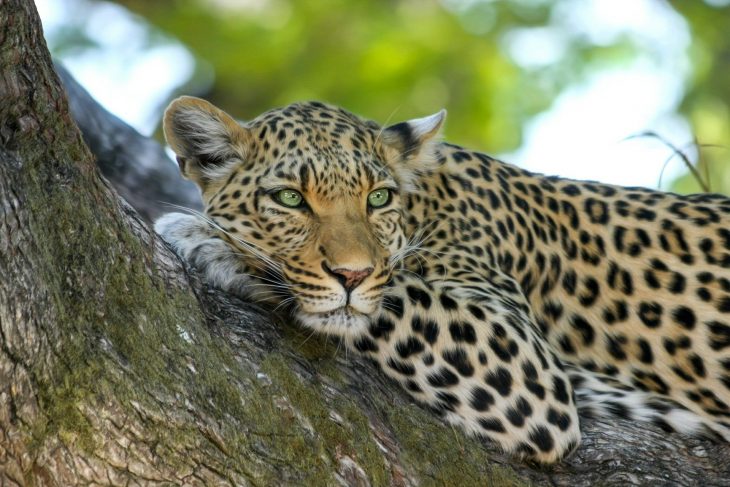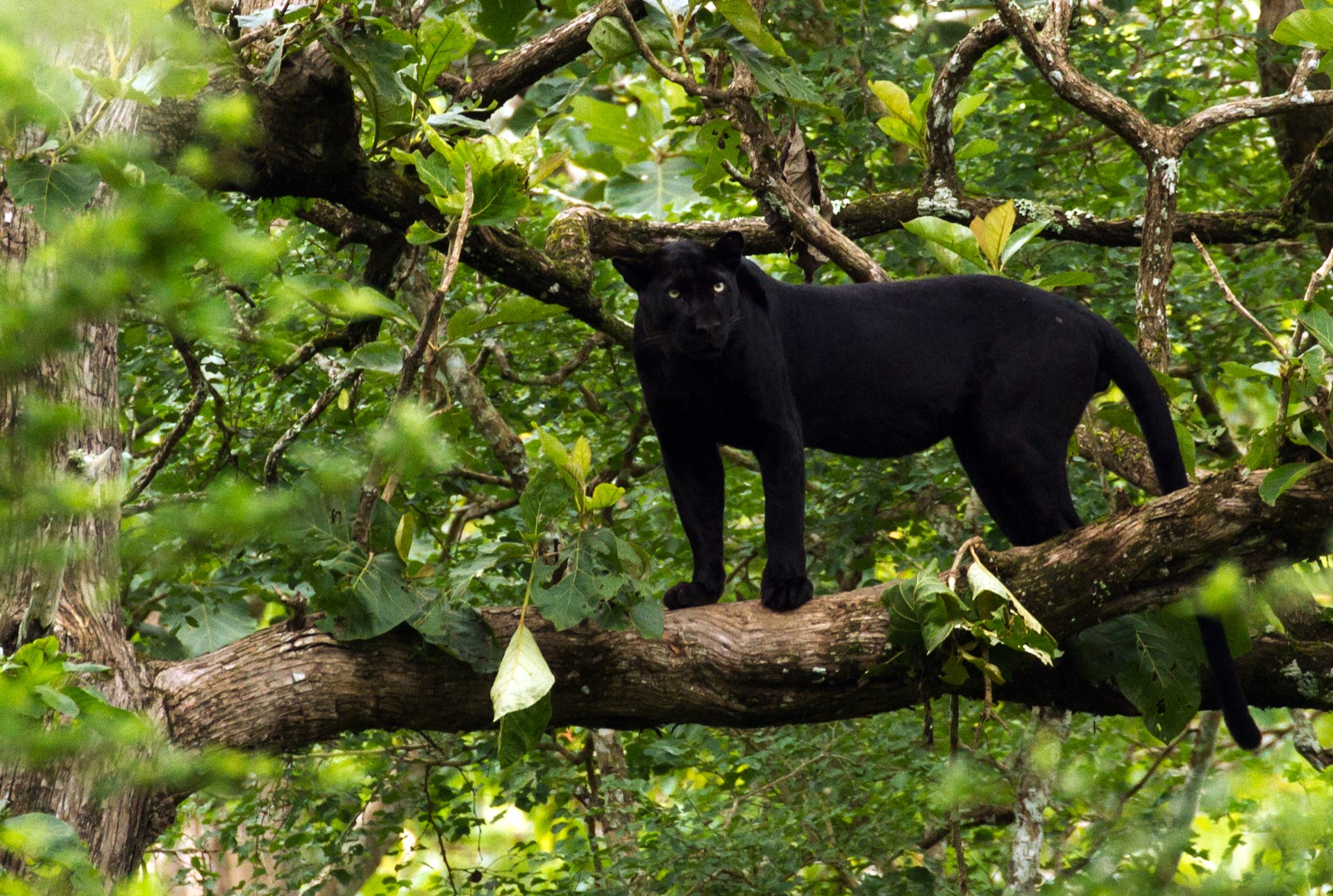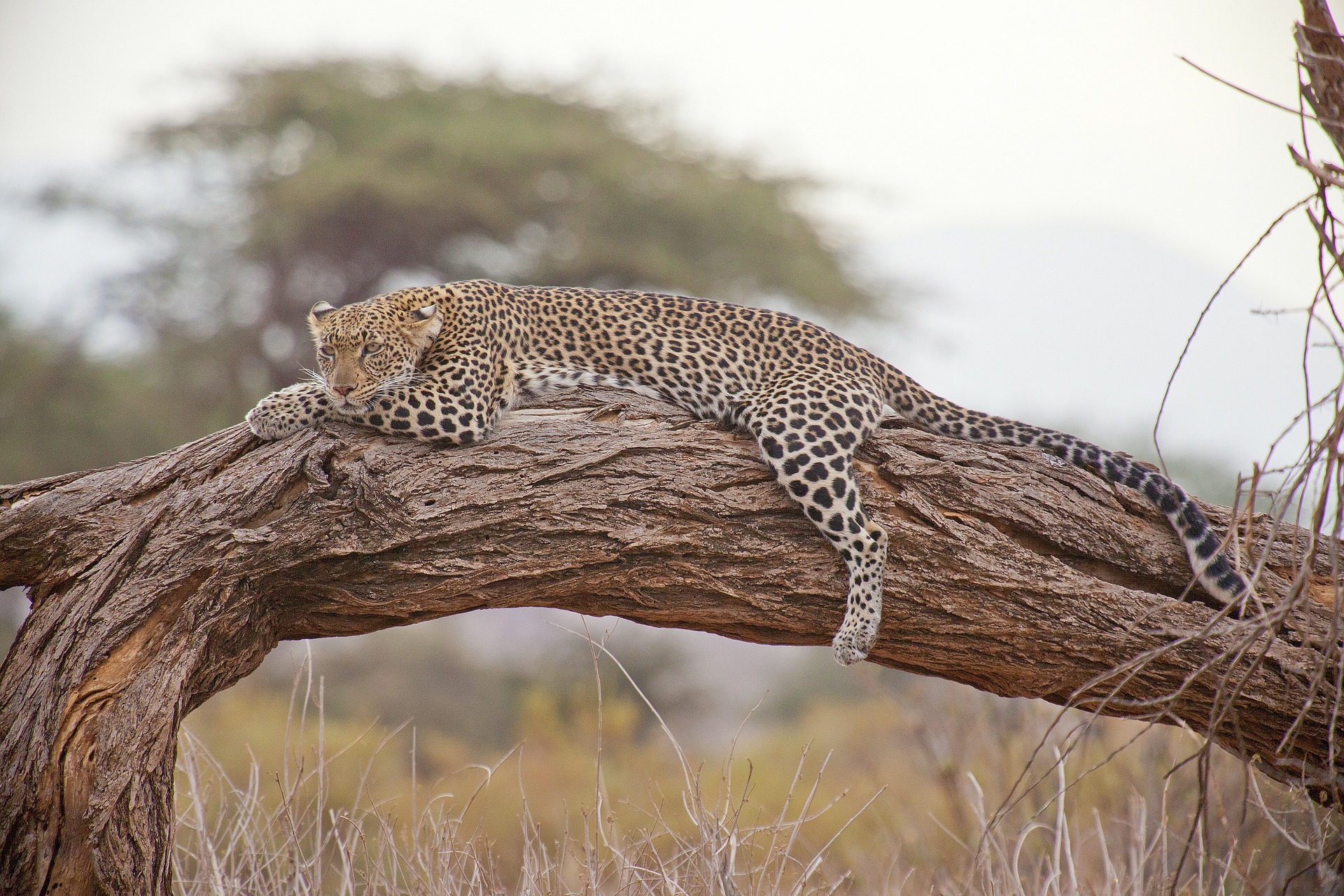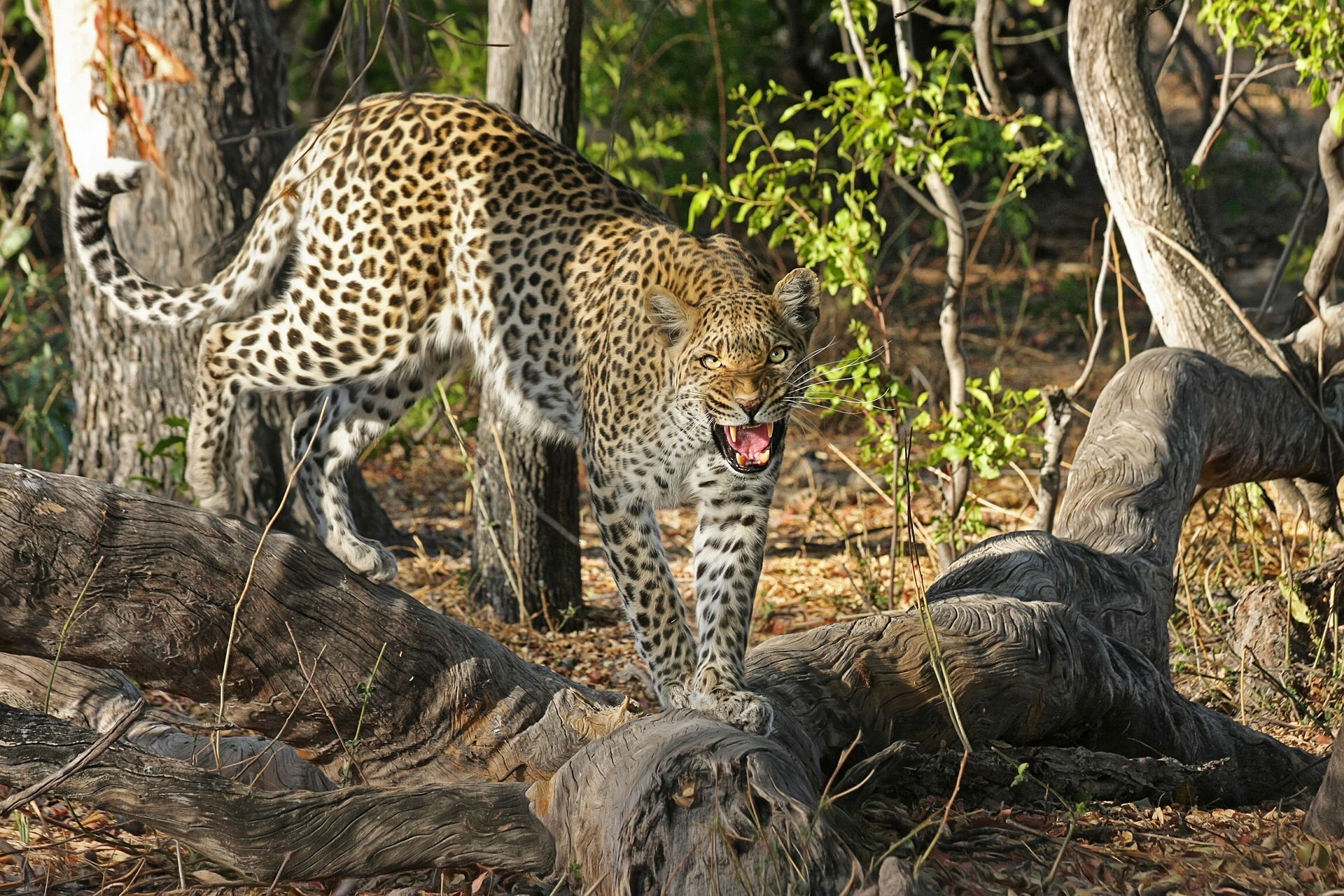
Leopards are wild cats that are certainly charismatic because of their magnificent spotted fur. These beautiful yet dangerous cats occupy a wide variety of terrain and are prominent in many parts of Africa and Asia. Although leopards are strong and stealthy, they still face fierce competition and numerous threats to their survival. Learn more about these endangered animals with these interesting leopard facts.
- There are nine known subspecies of Panthera pardus.
- In the genus Panthera, there are five living species. These are the tiger, the lion, the jaguar, the leopard, and the snow leopard.
- No two leopards look the same; each leopard has a unique spot pattern.
- In the 10th edition of Systema Naturae, Carl Linnaeus gave leopards the scientific name Felis pardus, the same genus as house cats.
- Leopards give birth after 96 days of pregnancy.
- Leopards have short legs in proportion to their long bodies.
- The scientific name of the leopard is Panthera pardus.
- The groups of spots on leopard fur are called rosettes.
- Baby leopards are referred to as cubs.
- Male leopards are typically larger than females.
- They belong to the cat family Felidae.
- Leopards live in a wide range of habitats such as scrub forests, grasslands, rainforests, and steppes.
- They are the smallest members of the genus Panthera, although sizes can vary by region. The largest known leopard measured up to 8 ft 7 in (261 cm) in head-and-body length and weighed around 173 lb (78.5 kg).
- Leopards are nocturnal animals and hunt primarily at night. However, they can also sometimes hunt during the day.
- In colder climates, leopard fur tends to grow longer.
- Sabor, one of the antagonists in the 1999 Disney film Tarzan, is a leopard. Bagheera in The Jungle Book is a black panther, specifically a melanistic Indian leopard.
- The Greek god Dionysus is said to wear leopard skin and use leopards as his mode of transportation.
- A 20th-century West African society took inspiration from this fierce cat. The Leopard Society was a secret society that practiced cannibalism.
- Many spotted animals have the word “leopard” in their names, such as leopard geckos, leopard sharks, and leopard seals.
- One cat genus, Leopardus, includes eight species of small, spotted cats. Despite the name, the genus doesn’t include the leopard.
Their name stems from the words leon and pardo.
The English word “leopard” originates from the Greek word leopardos. The word leopardos itself originally referred to cheetahs and is a compound word consisting of the terms leon and pardo. Leon roughly translates to “lion”, while pardos could mean “panther” and stems from the Greek word pardalotόs, meaning “spotted”.
Their spots provide excellent camouflage.
One of the most apparent leopard facts is that they have groups of spots or rosettes that help them blend in with their surroundings. Their fur color is typically pale yellow to dark gold, and they sport white-colored bellies. This coloration, along with their characteristic spots, provides excellent camouflage in the wild, hiding them against the foliage of trees, shrubs, and other plants. Their camouflage helps them avoid detection from both predators and prey.
Leopards bear similarities with jaguars and cheetahs.
Although leopards look quite similar to jaguars and cheetahs because of their common coloration and the spots on their fur, they have a lot of notable differences as well. These large cats vary considerably in size, geographical range, behaviors, and even the patterns of their spots!
Leopards occupy many parts of Africa and Asia, from sub-Saharan Africa to parts of East Asia. It also has some populations from European Russia to Southeast Asia. Cheetahs, on the other hand, live in a much more limited range in Africa and Iran, while jaguars live in the Americas. Among the three, the jaguars are the largest, followed by leopards, then cheetahs.
Cheetahs also have a simple polka dot pattern, while leopards have spots that come together in a small, polygonal, rose-like pattern (hence the term “rosette”), and jaguars have larger rosettes that have central spots. Certainly some of the most essential leopard facts to remember.
Black panthers are just leopards or jaguars with genetic mutations.

If you’ve ever wondered what a black panther really is, then you might be surprised to learn that it isn’t a separate or specific animal. It could be either a jaguar or a leopard with a genetic mutation that causes an excess in black pigments. Such animals exhibit melanism, which you can think of as the opposite of albinism or the complete lack of pigments. In leopards, the recessive allele is responsible for this genetic variation, and some scientists believe that this coloration could be more of an advantage in areas with denser vegetation and low-light conditions.
Interestingly, in many cases, the black panthers still have their characteristic rosettes. However, the spots are darker than most of their fur but more difficult to detect because of the black background coloration. Some researchers call these spots “ghost rosettes”.
They are expert hunters.
One of the most interesting leopard facts is that they are successful hunters that mainly track their prey using their keen senses of sight and hearing. These nocturnal hunters usually hunt on the ground. They are ambush predators and usually stalk their prey and try to get as close as possible while avoiding detection. Afterwards, they pounce on their prey, biting down on their necks with their powerful jaws and large teeth. For larger prey, they may grapple the animals’ necks to strangle them. More interestingly, some leopard populations reportedly jump down from trees to attack unsuspecting prey.
They aren’t picky eaters.
Leopards are opportunistic carnivores that eat a wide variety of prey depending on what’s available near their territories — and they aren’t picky eaters. Although they prefer medium-sized prey such as impalas, spotted deer, and bushbucks, they also eat small and large prey. Leopards may also prey on monkeys, arthropods, bamboo rats, tufted deer, elands, and even young giraffes on some occasions. These ferocious cats may also feed on other carnivores such as cheetahs, jackals, genets, and foxes. In some cases, they may scavenge or steal the kills of hyenas and lions. Male leopards eat an average of 7 lb 11 oz (3.5 kg) of food in a day, while females eat a daily average of 6 lb 3 oz (2.8 kg).
Leopards often live near trees.
In many of their habitats, leopards use trees to their advantage. They are excellent climbers and are the most arboreal among the big cats. Leopards often retreat to trees when they face threats and aggression. During the day, they sleep on the branches of trees to avoid detection from other predators.
Leopards also store their prey on tree branches to prevent other predators such as hyenas from stealing their kills. Their large skulls and strong jaws allow them to carry even animals larger and heavier than themselves (such as young giraffes and rhinoceroses) onto tree branches. When there aren’t many trees available in their terrain, then they prefer shrubs and rocks.
Leopards are solitary animals.

Generally, leopards are solitary and prefer to hunt and rest alone, with adult leopards typically only meeting up to mate. Leopards can track each other through scent, and the females release certain pheromones when they’re ready to mate. They are quite territorial and tend to avoid each other even in captivity, usually keeping a social distance of half a mile (1 km) apart. Leopards mark their territories with urine, feces, and claw marks.
They can leap up to 20 feet forward.
Leopards are such lethal hunters not just because of their stealth and strength, but also because of their speed and agility. They may not be able to run as fast as cheetahs, but they’re capable of reaching top speeds of over 36 mph (58 km/h). For comparison, Usain Bolt, the fastest human runner, ran a top speed of 27.78 mph (44.72 km/h) in 2009. Leopards can also leap up to 20 ft (6 m) forward. Leopards are also capable of jumping vertically up to 10 ft (3 m). How’s that for some interesting leopard facts?
Leopards are strong swimmers.
In addition to being expert climbers, leopards are also strong swimmers. They are some of the few cats that are quite comfortable in the water. When they swim, they can catch a variety of aquatic prey such as crabs and fish.
Leopards are closely related to lions.
Recent genetic studies suggest that the closest relatives of leopards are lions. Fossils of their ancestors date back to around 2 to 3.5 million years ago, but modern leopards likely evolved in Africa as recently as 0.5 to 0.8 million years ago. From Africa, early modern leopards spread throughout Asia as well.
They can breed with other species of big cats.
Although they are aggressive towards other big cats in the wild, leopards in captivity have been bred with other big cats. Captive leopards successfully interbred with lions in captivity. When male leopards breed with female lions, then they produce leopons. The offspring of male lions and female leopards, on the other hand, are lipards. Jaguars also successfully bred with leopards, producing jagupards and leguars. Although there have been attempts to breed tigers and leopards, they only resulted in stillbirths.
Despite coming from different genera, pumas have also produced hybrid offspring with leopards, and these offspring were called pumapards. Recorded pumapards had leopard-like spots and notably exhibited a form of dwarfism with short legs and a long body.
They don’t need to drink much water to survive.
One of the most impressive leopard facts is that they don’t need to drink water every day to survive. In the wild, leopards drink water only every two to three days and mainly get their water requirements through the bodily fluids of their prey. In the Kalahari Desert, leopards may also sometimes feed on moisture-rich plants to meet their water needs. These plants include succulents, watermelons, Kalahari sour-grass, and gemsbok cucumbers.
Leopard roars sound similar to sawing wood.

Leopards communicate with other leopards using a variety of vocalizations, such as meows, purrs, growls, and snarls. They can also roar similar to other panthers like tigers, lions, and jaguars. Their characteristic roaring pattern is a repeated grunt that sounds similar to sawing wood. Definitely among the most important leopard facts to remember when you’re planning to visit the zoo or safari!
Leopards have white spots on their ears and tails, likely to help with communication.
Aside from vocalizations, researchers suggest that leopards also communicate with each other through visual cues. Leopards have white spots on their ears and tails, and scientists hypothesize that these spots aid with communication. They suggest that the white tips of their tails convey a signal that says “follow me” to other leopards.
Leopards usually breed during the rainy season.
As solitary animals, leopards don’t mate for life and typically mate with multiple partners throughout their lives. Although they can readily breed at any time of the year, they frequently breed more during the rainy season in May. Leopard populations in Siberia and China, however, breed more often in January and February. Leopards typically reach sexual maturity at 2 years of age, and females usually stop breeding at the age of 8.5 years. Females give birth once every 15 to 24 months.
They usually give birth to 2 to 4 cubs.
After around 96 days of pregnancy, leopards give birth to 2 to 4 cubs. They give birth in caves, rock crevices, hollow tree trunks, or in dens. The cubs don’t open their eyes until around four to nine days after birth. They become more or less independent at one year of age but often will remain with their mothers until 18 to 24 months of age. However, many young leopards die before reaching maturity. Around 41–50% of them die within their first year of life.
Wild leopards have an average lifespan of 12 to 17 years.
In the wild, leopards typically live up to 12 to 17 years of age. In captivity, on the other hand, they can live much longer. The oldest recorded leopard was a female leopard in McCarthy’s Wildlife Sanctuary in The Acreage, Palm Beach County, Florida. This leopard, Roxanne, died in 2014 at 24 years, 2 months, and 13 days of age.
African leopards have the largest geographic range of all leopard subspecies.
Among the nine subspecies of leopard, the African leopard (Panthera pardus pardus) has the largest range. This widespread subspecies occupies most parts of Africa south of the Sahara. There are also African leopard populations in North Africa.
The Arabian leopard is the smallest leopard subspecies.
Arabian leopards (Panthera pardus nimr) are the largest wild cats in the Arabian Peninsula. However, they are the smallest subspecies of leopard, with the males having a length of 72–80 in (182–203 cm) from head to body. Females are slightly smaller, having an average length of only 63–76 in (160–192 cm). The males weigh around 66 lb (30 kg), while the females are 44 lb (20 kg) in weight. In contrast, the Persian leopard (Panthera pardus tulliana) is the largest subspecies, measuring up to 102 in (259 cm) in length.
They rarely attack humans.

Leopards rarely approach humans, and they’re less likely to become man-eaters compared to lions and tigers. While they feed on monkeys and apes, they rarely feed on humans. They’re more likely to come into conflict with humans by attacking their livestock. However, when their usual prey animals become scarcer, they will resort to attacking humans.
They can develop a preference for humans once they get a taste of their flesh.
This is easily one of the most disturbing leopard facts. Leopards are opportunistic feeders that may sometimes scavenge on human remains. Once they get a taste of human flesh (either through feeding on corpses or attacking humans), it’s possible for them to develop a preference for human meat. In some cases, they may even feed almost exclusively on humans. Most notably, in one instance, the Leopard of Rudraprayag in India ate a 14-year-old boy instead of the goats that he was guarding.
One leopard was responsible for at least 400 human deaths.
Among the most notorious man-eating leopards was the Leopard of Panar, a male leopard that lived in Northern India. He was responsible for at least 400 human deaths in the early 20th century. The renowned British hunter Jim Corbett, who also killed the Leopard of Rudraprayag, hunted down the Leopard of Panar in 1910.
Leopards face a lot of competition in the wild.
The habitats of wild leopards coincide with many other predators, and they face a lot of competition in those territories. Among their competitors are other large predators such as African wild dogs, bears, cheetahs, hyenas, lions, and tigers. Lions and tigers rarely kill adult leopards, but they reportedly kill young leopards especially when resources are scarce. Furthermore, lions sometimes steal the prey that leopards store on the branches of trees. Nile crocodiles can also attack leopards while they swim or hunt near riverbanks.
Humans often hunt them as trophy animals.
Because of their eye-catching fur patterns, humans sometimes hunt these majestic animals to use their fur as coats, rugs, and other ornamental pieces. Moreover, leopards are sometimes the victims of human persecution, especially when farmers view them as threats to their livestock. Poachers also kill leopards to get various body parts, which some cultures use as traditional medicine.
They currently only occupy a quarter of their historical range.
Leopards still remain the most widespread of all the big cat species, but they now occupy only 25% of their historical range. Their populations are now more fragmented due to human habitat expansion, which contributes to deforestation and other habitat disturbances. Although leopards are relatively tolerant of human disturbance, they still suffer from a decreasing habitat range.
Leopard populations are steadily declining.
Because of their fierce competition against other large predators, habitat loss, as well as their conflicts with humans, leopards now face the threat of extinction. Although leopards are the most populous among the big cats, almost all of the subspecies of leopards range from vulnerable to critically endangered, according to the International Union for Conservation of Nature (IUCN) Red List of Threatened Species. Many animal conservation organizations now make efforts to manage leopard populations and prevent their extinction.
The Amur leopard is among the rarest cats in the world.
Among all the leopard subspecies, the Amur leopard (Panthera pardus orientalis) is the rarest subspecies. Reports from 2007 stated that there were only as few as 19 to 26 wild individuals left, making them one of the rarest cats on Earth. Fortunately, their populations have since improved, and as of 2019, the number of Amur leopards rose up to 90 individuals. Now that’s some good news to conclude this list of amazing leopard facts!
Leopard print is still a big deal in fashion.
Leopard prints – and feline prints in general – represent fierceness and strength, especially in women. Goddesses from different mythologies wear leopard motifs and signify wealth. The print’s significance changed over time, becoming tacky and cheap, until stars like Beyonce and fashion bigwigs such as Anna Wintour popularized it again.
The superhero film "Black Panther" gives representation to many Black people all over the world.
Black Panther is a Marvel comic that turned into a movie in 2018, starring Chadwick Boseman, Lupita Nyong’o, Michael B. Jordan, and other big names. It had a huge impact, especially to the Black community. Prince T’Challa (Chadwick Boseman) is the first Black protagonist superhero in the Marvel Cinematic Universe. The film also portrayed the Black experience, especially in the face of police brutality and lack of Black representation in various spaces.
Was this page helpful?
Our commitment to delivering trustworthy and engaging content is at the heart of what we do. Each fact on our site is contributed by real users like you, bringing a wealth of diverse insights and information. To ensure the highest standards of accuracy and reliability, our dedicated editors meticulously review each submission. This process guarantees that the facts we share are not only fascinating but also credible. Trust in our commitment to quality and authenticity as you explore and learn with us.
